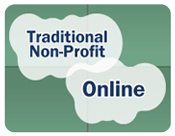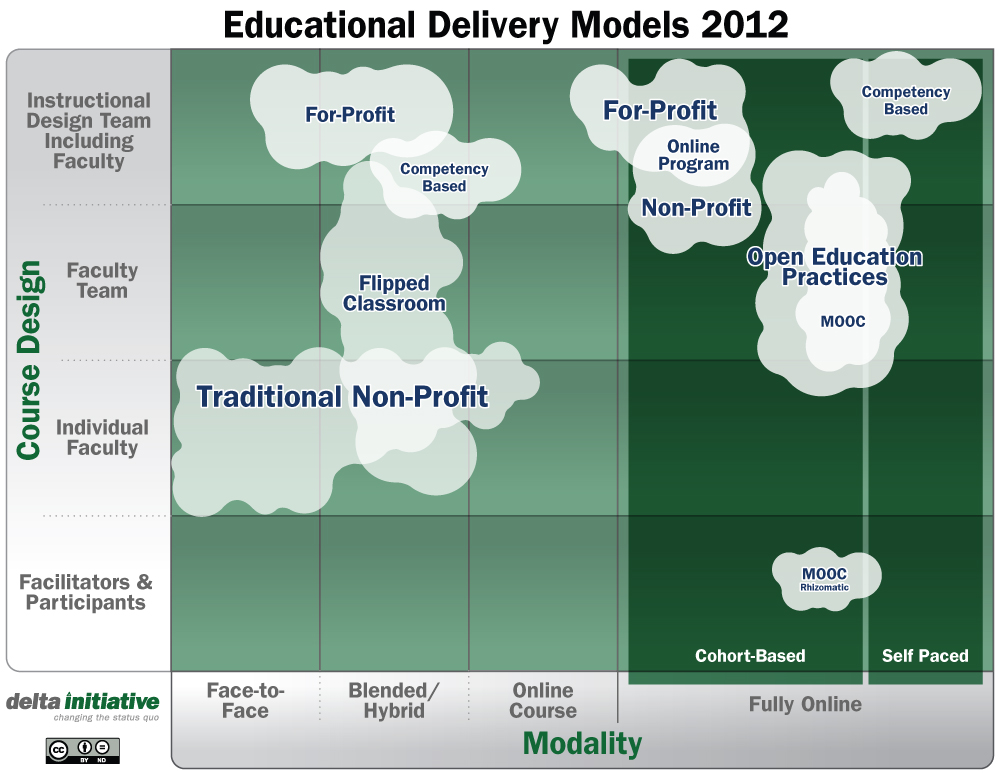Part 2 in this series, on a key difference in educational delivery methods, can be found here.
Traditional education or online education. In the past decade it seems that the dominant conversation has been around the potential for online learning, both from for-profit and non-profit options, to disrupt education as an industry.
What I believe we are seeing in 2011 and 2012 is a transition to an educational system no longer dominated by traditional education and one or two alternative models. As my colleague Molly Langstaff has described, educational technology and new educational courses and programs are interacting to create new language and models for education. What does this emerging landscape of educational delivery models look like?
While I do not claim to be able to solve this problem, I would like to offer a more descriptive view than the dichotomy of traditional and online education describes.
There is a growing number of models on how to deliver education effectively, which is natural given the investment and interest in fixing or disrupting education (and yes, I know these terms are over-used and often ignore the innovations happening within traditional educational circles). Not all of these models will end up thriving in the long-term, but I do foresee that there is room for more than just two models.
For example, here’s one list of models, followed by a view of how they differ in terms of course design and the channel by which information is created and transmitted:
- Traditional Non-Profit Face-to-Face Programs
- Non-Profit Online Programs
- For-Profit, Both Face-to-Face and Online Programs
- Competency-Based
- Open Education Practices
- Massively Open Online Courses, or MOOCs
- Flipped Classroom
Why does it matter that we describe these educational delivery models with finer granularity than just traditional and online? Because the aims of the models differ, as do the primary methods of how these models are created and delivered. As an example, there are really two variations of MOOCs with quite different approaches – witness the Stanford and MITx version vs. the rhizomatic version. Given the changing landscape, the judgment of how successful these models will become, as well as how well learning platforms help solve the associated problems should differ as well.
I plan to write several upcoming posts looking at some of the key attributes of these models and how educational technology is serving these models.
How well does this landscape describe the existing and emerging educational delivery models? What elements are missing from this view?
UPDATE: Graphic changed to clarify faculty involvement with instructional design team


I really like the chart, Phil. Are you planning on addressing cost breakdowns (from an institutional perspective) in your upcoming posts?
Rob, I hadn’t thought about addressing cost breakdowns directly, but maybe now . . .
Also happy if others build on this model if desired.
Phil:
Like the diagram but believe it’s inaccurate regarding for-profits. All of the courses at our for-profit, American Public University System, are proposed and developed by faculty. After that, instructional designers are used to refine the appearance and effectiveness of the course. This diagram implies no faculty involvement. I can’t speak for others, but the diagram does not represent our entire sector. In addition, how would you portray online courses that are developed by educational corporations and utilized by non-profits and possibly for-profits without a base of online programs?
Wally
Wally, by “Instructional Design Team” I did not mean to imply that faculty are not involved in the design process. Some for-profits originate the design in a team setting, with faculty and instructional designers and occasionally industry experts and QA; but some originate the design by faculty and then have instructional designers modify (as you have described). I should clarify this within the graphic, so thanks for the feedback.
On the second case, are you referring to courses designed by third-party service providers such as 2tor or Embanet/Compass? If so, I might need to add another row. Good question.
I really like your train of thought. Can I add that some ed-tech is actually aimed at enhancing the educators so they can do their work faster and better? I’m thinking mostly of tools that alleviate the effort involved with assignment correction and lesson preparation. With the time saved, those same educators can then decide what will add most value: more one-on-one contact, more students per class or more assignments are just some examples. Myself I like to refer to the “bionic” teacher to describe these solutions.
Jeroen, you make a good point that ed tech also can help educations work faster and better. The challenge is – if done well, including proper technology and institutional support. I’ve seen examples where ed tech helps create these “bionic” teachers, but I’ve also seen examples where it adds to faculty burden. Luckily, I think the recent market changes have provided more usable systems.
Phil, I couldn’t agree more. In fact, those solutions that only clutter the classroom and add to the educators’ burden (the majority) don’t even classify as bionic in my book as they don’t enhance teachers’ capabilities. The main criteria should be how useful they are and whether they are either directly quality-improving or productivity-increasing or – preferably – a mix of both.